
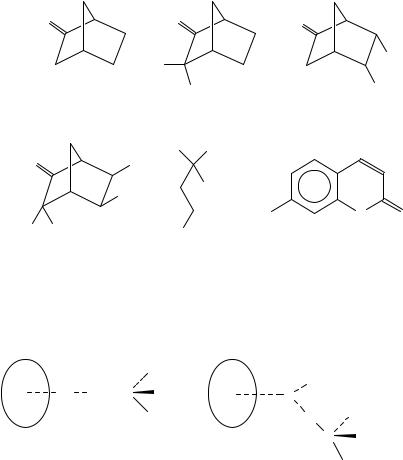
|
17. Syntheses and uses of isotopically labelled compounds |
1069 |
|||
O |
|
O |
|
O |
|
|
|
D |
|
|
D |
|
|
|
|
|
|
|
|
|
D |
|
D |
|
(497a) |
|
(497b) |
(498) |
|
|
|
|
|
|
|
|
|
Ph |
D |
|
|
O |
|
D |
|
|
|
|
|
D |
D |
|
|
|
|
|
|
|
|
|
|
|
CH3 CD2 |
O |
O |
D |
D |
Ph |
|
|
|
|
|
|
|
|
|
|
(499) |
(500) |
(501) |
|
|
pyruvate, defined by equation 294,
|
|
|
|
|
|
|
I(V/K) D ln 1 f /fln[1 f SAf/SA0]g |
294 |
|||||||
|
|
|
|
|
|
|
|
|
|
|
|
|
|
Z |
|
M |
|
|
O |
|
H |
|
C |
|
|
|
|
Z = leaving group |
|||
|
|
|
|
M |
O |
||||||||||
|
|
|
|
||||||||||||
|
|
|
|
|
|
|
|
|
|
|
|
|
|
H |
|
|
|
|
|
|
|
|
|
|
|
|
|
|
|
|
C |
|
|
|
|
|
|
|
|
|
|
|
|
|
|
|
|
|
|
(502) linear TS |
|
(503) bent TS |
|
||||||||||
where f is the fractional conversion to product, SAf is the specific activity of the product at the degree of conversion equal to f, and SA0 is the initial lactate specific activity, has been found to be of 15.8 š 1.7 and 11.3 š 0.5 for the wild-type and the Y143F mutant. The detailed analysis of the above results led the authors603 to the conclusion that the determined hydrogen IEs for FMN reduction are intrinsic IE values [k2(H)/k2HŁ, HŁ D 2H or 3H], fully rate determining (k2 in equation 295), and that therefore the mutation induces a change in the structure of TS of hydrogen transfer. The Tyr 143 phenolic group (in the active side chain of the enzyme) stabilizes the Michaelis complex by H-bonding to a substrate carboxylate, but Tyr 143 does not play the role of electrophilic catalyst which stabilizes the carbanion-like TS 504 formed in the initial step (the hydrogen bond does not appear to be stronger in the TS)603. The 14C 2 and 13C 2 KIE determinations should help to choose the proper degree of C˛ H bond rupture in the TS for the Y143F mutant.
k1 |
k2 |
295 |
E C S |
ES ! EP |
|
|
|
|
k 1
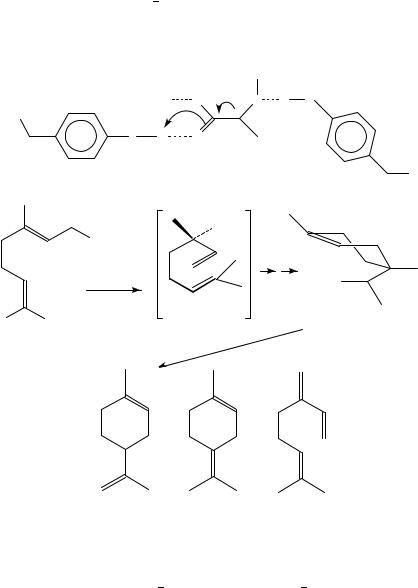
1070 |
Mieczysław Ziełinski´ and Marianna Kanska´ |
8. Deuterium and tritium isotope effect study of the methyl-methylene elimination in the enzyme catalyzed biosynthesis of (R)- and (S )- limonenes (506)
The mechanism and stereospecificity of the enzyme catalyzed cyclization of geranyl diphosphate, 505 to 506 and other monoand bicyclic unsaturated products, proceeds according to the established 605 609 mechanism (equation 296) involving a transient ˛- terpinyl carbonation intermediate 508 (produced from 507), which by the final proton elimination step yields 506. Recent tritium tracer and KIE610 study of this terminating proton transfer supplemented the biosynthesis of 506.
H
+−
|
|
|
R376 |
O |
O H O |
|
Y143 |
|
|
|
|
− |
|
|
|
O |
H |
O |
|
|
|
|
|
|
(504) |
|
Y256 |
|
|
|
|
|
|
|
10 |
|
|
|
|
|
|
3 |
1 |
|
|
|
OPP |
|
|
|
|
|
|
||
|
OPP |
|
|
|
|
|
6 |
Mg |
++ |
|
|
− |
+ |
|
|
|
|
OPP |
|
|
|
(−)pinene |
|
|
|
|
|
|
cyclase |
|
|
|
|
|
9 |
8 |
|
|
|
|
|
(505) |
|
|
(507) |
(508) |
|
|
|
|
|
|
|
−H + |
(296) |
|
|
|
|
|
|
|
+ |
+ |
+ bicyclic product |
(−)-(506)
[8-3H]-509, [8,8,9,9-2H4]-510, [1-3H, 8,9-2H6]-511 and [1-3H,10-2H3]-512 geranyl diphosphates have been synthesized605 and used in tritium tracer and DIE studies. Degradation of enantiomeric [3H]limonenes produced by cyclization of with (C)- and ( )-pinene cyclase from Salvia officinalis showed that methyl-methylene eliminations in this case occur at both the cis (55 65%) and trans-methyl (45 35%) groups. Terminating eliminations in the formation of 506 catalysed by limonene cyclase from Citrus sinensis or Perilla frutescens occur exclusively at the cis terminal methyl group (equation 297). The intramolecular DIE associated with CH3 ! CH2 eliminations, determined by
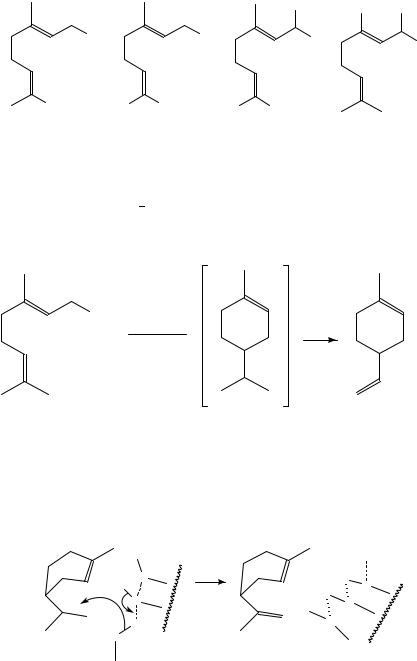
17. Syntheses and uses of isotopically labelled compounds |
1071 |
|||
|
|
T |
CD3 |
T |
|
|
|
||
OOP |
OOP |
|
OOP |
OOP |
|
|
|
|
|
CH2 T |
D2 HC |
CHD2 |
D3 C |
CD3 |
|
(509) -T |
|
(510) - D4 |
|
(511) - D6 , T |
(512) - D3 , T |
incubating 510-D4 with (C)- and ( )-pinene cyclase from S. officialis and with the ( )- limonene cyclase from Mentha spicata, have been found to be kH/kD D 2.3 š 0.2, 5.9 š 0.5 and 4.0 š 0.4, respectively. Negligible changes of deuterium content of the bicyclic products have been observed, since in their synthesis no C D bonds are broken. Remote IEs kH/kD D 1.16 1.27 of the deuterium substitution at the internal C 10 and terminal methyl group C 8 C 9 on the total rate of monoterpene formation have been observed by incubation of 511-D6,T and 512-D3,T with pinene and bornyl PP cyclases from S. officinalis.
OOP
limonene  −H+ (297) cyclase
−H+ (297) cyclase
+
The sizable secondary-D KIEs observed for 512-D3,T are explained by slight destabilization of the intermediate geranyl carbocation/MgOPP2 anion pairs at the enzyme active site, and by the weaker electron-donating capacity of the deuteriomethyl group. Terminal CH3 ! CH2 elimination occurs at the cis-methyl group in monoterpene (equation 296) because this cis-methyl group is positioned nearer to the negatively charged MgOPP2 leaving group, and the charge separation is less in the TS for proton transfer from the cis-Me group to the basic acceptor B(H2O, imidazole group of the histidine residue) in the enzyme active site (equation 298).
|
|
MgOPP2 − |
MgOPP2 − |
|
|
|
|
H |
|
|
|
|
H |
O |
|
H |
O |
|
|
H |
|
||
+ |
|
O |
O |
(298) |
|
|
H |
|
|||
|
|
|
|||
|
|
H |
B |
|
|
|
B |
|
|
|
|
The direct transfer of the proton to the MgOPP2 dianion require considerable movement and reorientation to bring the cis-Me and MgOPP2 groups into close proximity.
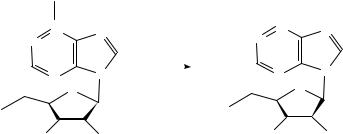
1072 |
Mieczysław Ziełinski´ and Marianna Kanska´ |
The differences in primary hydrogen KIE observed are usually related to varying extents of proton transfer in the TS, by nonlinear TS and by tunneling. An attempt has been made610 to rationalize the different values of intramolecular KIEs by involving processes specific for enzyme catalyzed reactions like e.g., occurrence of conformational inversion prior to proton elimination. The sizable secondary KIEs follows also from the general kinetic equation relating the observed kH/kD ratios with ki H/ ki D and ki/ki 1 H ratios for consecutive sets of all reversible reactions taking place in the enzyme surface. The initial cyclization step of the enzyme-bound intermediate is an important component of the overall rate of the enzymatic reactions.
9. Carbon-14 and nitrogen-15 heavy-atom KIEs in the hydrolytic deamination of adenosine 5-monophoshate (AMP 513) with AMP deaminase
AMP-aminohydrolase from Saccharomyces cerevisiae catalyses the reaction 299, where R2H is the enzymatic proton donor, Glu633, ATP is an allosteric activator and GTP is an allosteric inhibitor511,612.
15NH2 |
|
|
|
|
|
OH |
|
|
|
|
|
|
14 |
|
|
|
|||
|
|
|
|
|
|
|
|
||
14 |
C |
N |
|
|
C |
N |
|
||
N |
|
|
N |
|
|
|
|||
|
|
|
|
|
|
|
|
||
R2 H |
|
|
+ |
A TP |
|
|
|
+ 15NH3 |
|
|
N |
|
RH |
N |
N |
||||
|
|
||||||||
N |
|
−GTP |
O |
|
|||||
|
O |
|
|
|
|
|
|
|
|
PO4 |
|
|
|
|
PO4 |
|
|
|
|
HO |
|
OH |
|
|
HO |
|
|
OH |
|
(513) AMP |
|
|
|
|
|
(514) IMP |
(299) |
||
|
|
|
|
|
|
|
|
|
|
Carbon-14 KIEs for [6-14C]AMP have been found613 to equal 1.030 š 0.003, 1.038 š 0.004 and 1.042 š 0.003 in the absence of effectors and in the presence of ATP and GTP respectively (ATP D adenosine 50 -triphosphate, GTP D guanosine 50-triphosphate).
The nitrogen-15 IE for [6-15N]AMP was found to be 1.010 š 0.002. In the presence of ATP the average value of 15 Vmax/km increased to 1.014 š 0.003. In D2O, [6-15N] KIE decreased from 1.011 š 0.001 to 1.007 š 0.002, The previously determined612 solvent D2O effect with AMP substrate was inverse (0.79).
A fully concerted mechanism for reaction 299 has been eliminated as inconsistent with 14C and 15N KIEs and also with the observed inverse solvent D2O effect. The reaction path for the deamination of AMP has been formulated613 as a stepwise conversion involving the formation of tetrahedral intermediate 515 characterized by full-bonded hydroxyl and amino groups (equation 300). The TS for slow formation of 515, resulting from the attack of the hydroxyl from enzyme ‘zinc-activated water’ at the C 6 , is characterized by the C 6 OH bond order of 0.8 š 0.1 (late TS) and fully bonded NH2, that is by the nearly complete conversion to sp3 at C 6 , and by nearly complete protonation of N 1 , 516, The protonation of NH2 (in 515) and departure of NH3 (with TS 517) take place in the subsequent rapid steps as shown in equation 300, Zinc hydroxide is formed prior to attack514 at C 6 . Enzymatic degradation of [6-14C]AMP has been carried out to prove the position of the radiolabel in 513 (equation 301). No radioactivity in the allantoin

17. Syntheses and uses of isotopically labelled compounds |
1073 |
generated from [6-14C]AMP has been found, thus only C 6 was radiolabelled in 513.
|
|
|
|
|
|
|
|
|
1 |
|
|
|
|
|
|
|
|
|
|
|
|
Zn |
|
|
|
Zn |
H |
|
|
|
|
|
|
|
H |
|
|
|
|
O |
|
|
||
|
Zn |
|
|
|
O |
15 NH2 |
|
|
1 5NH2 |
|
||||
|
O |
+ AMP |
|
|
|
|
|
|
1 4C( 6 ) |
|
||||
|
|
|
|
|
|
1 4C( 6 ) |
|
2 |
|
|||||
|
|
|
|
|
|
|
|
|
|
|
|
|||
|
|
|
|
|
|
|
R2 |
HN( 1) |
|
|
R |
HN( 1) |
|
|
|
R |
2 |
H |
|
|
|
|
|
|
|||||
|
|
|
|
|
|
|
|
|
|
|||||
|
|
|
|
|
|
|
|
|
|
|
|
|||
|
|
|
|
(513) |
|
|
|
(516) |
|
|
(515) intermediate |
|
||
|
|
|
|
|
|
|
Zn |
H |
|
|
|
|
|
|
|
|
|
|
|
|
|
O |
1 5NH3 |
|
|
|
|
|
|
|
|
|
|
|
|
R2 |
|
1 4C |
|
Zn |
|
+ 514 + 15NH3 |
||
|
|
|
|
|
|
HN( 1) |
|
R2 H |
|
|
|
|||
|
|
|
|
|
|
|
|
|
|
|
||||
|
|
|
|
|
|
|
|
|
|
|
|
|
||
|
|
|
|
|
|
|
(517) |
|
|
|
|
|
(300) |
|
|
|
|
|
|
|
|
|
|
|
|
|
|
|
|
|
|
|
|
|
|
|
|
|
|
|
|
|
O |
|
|
|
|
|
|
alkaline |
|
HO |
|
O |
adenosine |
|
14 C |
|
|
|
(513) (AMP) |
phosphatase |
|
|
deaminase |
|
|
|||||||
|
−PO4 |
|
|
|
|
−NH3 |
HN |
|
||||||
|
|
|
|
|
|
|
|
|
|
|||||
|
|
|
|
|
|
|
|
|
|
|
|
|||
|
|
|
|
|
|
|
|
HO |
OH |
|
|
|
|
|
|
|
|
|
|
|
|
|
adenosine |
|
|
inosine |
|
||
|
|
|
|
|
|
|
|
|
|
|
|
|
||
|
|
|
|
|
|
|
|
|
|
|
|
|
sodium arsenate |
|
|
|
|
|
|
|
|
|
|
|
|
|
−ribose |
of purine |
|
|
|
|
|
|
|
|
|
|
|
|
|
nucleoside |
|
|
|
|
|
|
|
|
|
|
|
|
|
|
|
|
|
|
|
|
|
|
|
|
|
|
|
|
|
|
phosphorylase |
|
|
|
|
|
|
|
|
|
O |
|
|
|
|
O |
|
|
O |
|
|
NH |
|
|
14 C |
NH |
|
|
14 |
C |
N |
|
|
|
|
|
|
HN |
|
|
HN |
|
|||||
|
H2 N |
|
|
|
|
−14 |
CO2 |
|
|
2 O |
|
|
||
|
|
|
|
O |
|
|
O |
|
|
|
||||
|
|
|
|
|
uricase |
|
|
xanthine |
|
|
||||
|
|
|
|
|
|
|
|
|
oxidase |
|
|
|||
|
|
|
|
NH |
|
O |
NH |
NH |
|
N |
NH |
|||
O |
NH |
|
|
|
|
|
|
|||||||
|
|
|
|
|
|
|
|
|||||||
|
(allantoin) |
|
|
|
uric acid |
|
|
|
hypoxanthine |
|||||
(301)
10. Oxidative decarboxylation catalysed by malic enzyme
The problem of stepwise versus concerted oxidative decarboxylation of L-maleate to yield pyruvate CO2 and reduced dinucleotide catalysed by malic enzyme615 has been reinvestigated recently616. The new D and T KIE determinations, using L-malate-2D

1074 |
Mieczysław Ziełinski´ and Marianna Kanska´ |
and L-malate-[23H] (equation 302), combined with 13C isotope effects determined previously616 led the authors616 to the conclusion that the stepwise mechanism for oxidative decarboxylation of L-malate with AND(P) changes to a concerted one with alternative dinucleotides such as 3-APAD, where AND denotes nicotinamide adenine dinucleotide, AND(P) denotes nicotinamide adenine dinucleotide 20 -phosphate and 3APAD denotes 3-acetylpyridine adenine dinucleotide, The hydride transfer step is preceding decarboxylation with dinucleotides AND or NADP.
|
|
|
|
|
malic enzyme |
+ CH3 CCOOH |
|
|
|
||||||||||||||||
HOOCCHCH2 COOH |
|
|
|
|
|
|
|
|
CO2 |
|
|
|
|||||||||||||
|
|
|
|
|
|
|
|
|
|
|
|||||||||||||||
|
|
|
|
|
|
Mg2 +, 25 °C, pH 7 |
|
|
|
|
|
|
|
|
|
|
|||||||||
|
|
|
|
|
|
|
|
|
|
|
|
|
|
|
|
||||||||||
|
|
|
OH |
Herpes buffer |
|
|
|
|
|
|
|
O |
|
|
|
||||||||||
H |
= D or T |
|
|
|
|
|
|
|
|
|
|
|
|
|
− |
|
|
|
|||||||
|
|
|
|
|
|
|
|
|
|
|
|
|
|
|
|
|
|
|
|
|
O |
||||
|
|
|
|
|
|
|
|
|
|
|
|
|
|
|
|
|
|
|
OOC |
|
|
||||
− |
|
|
|
− |
|
− |
|
|
− |
Me2 + |
|
|
|
C |
|||||||||||
OOCCHCH2 COO |
|
|
OOCCCH2 COO |
|
|
|
|
|
|
|
|
(302) |
|||||||||||||
|
|
|
|
|
|
|
|
|
|
|
|
|
|
|
|
|
|
|
|
|
|
|
|
|
O− |
|
|
|
|
|
|
|
|
|
|
|
|
|
|
|
|
|
|
|
|
|
O |
|
|
||
|
OH |
|
|
O |
|
|
|
|
|
|
|
|
|
|
|
||||||||||
|
|
|
|
|
|
|
|
|
|
|
|
|
|
|
Me21/2+ |
||||||||||
|
|
|
|
|
|
|
|
|
|
|
|
|
|
|
|
|
|
|
|||||||
|
|
|
|
|
|
|
|
|
|
|
|
|
|
|
|
− CO2 |
|
|
|
||||||
|
2 + |
= divalent |
|
CH2 |
|
|
|
|
|
CCOOMe1/2 |
|
|
|
|
|
CH3 |
|
CCOOMe1/2 |
|||||||
|
Me |
|
|
|
|
|
|
|
|
|
|
|
|
||||||||||||
|
|
|
|
|
|
|
|
|
|||||||||||||||||
|
metal ion |
|
|
|
|
|
|
|
|
|
|
|
|
|
|
|
|
|
|
|
|
||||
|
|
|
|
|
|
|
OH |
|
|
|
|
|
|
|
O |
||||||||||
|
|
|
|
|
|
|
|
|
|
|
|
|
|
|
|
|
|
|
|||||||
11. Brief review of biochemical studies with isotopes
The 13C KIE associated with the synthesis of methane from acetate by M. barkeri (Me carbon of acetate ! methane) has been found617 to be 21.3% at 37 °C. The isotope effect at the carboxyl portion of acetate was practically the same, Both carbon atoms in acetate are involved in the RDS as expected for reactions catalyzed by carbon monoxide dehydrogenase. The 13C/12C fractionation ‘˛’ of methane produced during microbial
oxidation in a forest soil was determined618 |
to be 0.978 |
š |
0.004. This corresponds to |
|||||||||
13 |
C KIE, k /k |
. |
. |
The T and |
14 |
|
|
|
|
|||
|
|
C KIEs in the whole-body with either |
||||||||||
|
14 |
12 |
13, of 13 022 |
š 0 004. |
14 |
|
|
|
|
|
3 |
H]KIC |
[1- |
C]leucine or [4,5- H]leucine or [1- C]˛-ketoisocaproate (KIC) and the [4,5- |
|
||||||||||
turnover, infused simultaneously to dogs and humans, have been determined619. These small differential isotope effects have to be considered when dual isotope infusions are employed e.g. to study the amino acid metabolism.
The pharmacokinetic study of the 1 : 1 mixture of unlabelled (D0) and fully deuteriated toluene-D8 showed that toluene-D8 is a suitable probe for D0 kinetics620. The insecticidal potency of [dimethyl-D6]methoxychlor has been found621 to be higher than that of [monomethyl-D3]methoxychlor. The inverse15N KIEs, 15 V/K H2O D 0.995 and 15 V/K D2O D 0.992 found in the HIV-1 virus aspatric protease (retropepsin) catalysed peptidolysis of Al-Ser-Gln-ASn-Tyr-Pro-Val-Val-NH2, have been interpreted622 as indicating that the bonding to the N atom becomes stiffened in the TS of this reaction and that the KIEs arose from protonation of the proline N atom. The reaction sequence in this peptidolysis has been formulated622. Emodin deoxygenase transports the 4S hydrogen of NADPH in the rate-determining step623.
The KIE in the dehydration of fructose to 5-(hydroxymethyl) furfural has been determined624 and interpreted as arising in the rate-determining addition of HC to

17. Syntheses and uses of isotopically labelled compounds |
1075 |
4,5,6-trihydoxy-2-oxohexanal, DIEs in the reduction of 1,4-benzoquinones (BQ) and its derivatives and of Me benzoylformate (MBF) with 1-benzyl- 1,4-dihydronicotinamide, [4,4-(H,H)]BzNADH and [4,4-(H,D)]-BzNADH have been determined625,626 and suggestions concerning the change of the mechanism from single-step H transfer for BzNADH oxidation with MBF to a multistep e , HC , e transfer for BzNADH oxidation with BQ presented. The problem of product-determining and rate-determining steps in the reduction of BQ with BzNAH has been discussed also626. T KIEs in the enzymatic oxidation of tritium D-galactosamine, 518, have been determined in the presence of galactosooxidase627. The amino group affects mainly the formation of the enzyme substrate complex.
CR1R2 OH |
|
|
||||
|
|
|
O |
|
|
|
HO H |
(518) R1 |
= R2 = H, T |
||||
|
||||||
OH |
H |
OH |
= H, R2 = T |
|||
R1 |
||||||
H |
|
|
||||
|
|
|
|
|||
|
|
NH2 |
|
|
||
H |
|
|
||||
The oxygen-18 KIEs in the dopamine ˇ monooxygenase (D-ˇ M) reaction have been measured628. The trend in 18O isotope effect with reactivity has been explained by assuming that the O O bond of O2 undergoes cleavage prior to substrate activation. The D KIE observed in the microsomal oxidative demethylation of the methoxyl group was smaller
in the presence of added bovine serum albumin than in its absence629. The large primary (kH/kD) isotope effect of 60 (at RT and pH 9) has been observed530 in the oxidation of
[11, 11-2H2]linoleic acid by soybean lipogenase531. A primary D2O isotope effect has been observed532 at pH 7.0 in the oxidative degradation of tryptophan catalyzed by the hemoprotein, tryptophan 2,3-dioxygenase (Ec. 1.13.1.12). This implies that abstraction of the indole proton is at least partially rate-determining.
D. Isotope Effects in Photochemical and Physical Processes
1. Photochemistry of benzaldehyde and deoxybenzoin
The photochemistry of benzaldehyde (90% 13CDO), 519, deoxybenzoin (99%) 13CDO), 521, and p-chlorobenzoin (99% 13CDO), 522, in cyclohexane-D12 solution has been studied633 by spectroscopic techniques, such as 1H chemically induced dynamic nuclear634 or electron polarization635 (CIDNP/CIDEP) or dynamic nuclear polarization636 (DNP). In all these cases the formation of benzaldehyde-D with emissive 13CDO polarization has been observed and the results rationalized by intermolecular hydrogen (deuterium) abstraction by the photoexcited ketones from the solvent molecules and by reactions of cage-escaped radicals (equations 303 308), Benzoin, 520, is formed also.
Beside phenylcyclohexylmethanol, 523, the dicyclohexyl product 524 has been produced also by irradiation of benzaldehyde in cyclohexane (equation 309). Irradiation of 521 provided 1-cyclohexyl-1,2-diphenylethanol, 525 (equation 310). Benzylcyclohexane, 526, and dicyclohexyl, 524, have been formed in secondary encounteres (equation 310a).
It has been documented that the photoexcited deoxybenzoin can abstract H as well as D from appropriate solvents. Hydrogen abstraction by triplet 521 from cyclohexane-H12 (rate constant 2.1ð105 mol 1 s 1) is faster than ˛-cleavage whereas deuterium abstraction (3.9 ð 104 mol 1 s 1) is competitive with ˛-cleavage (deuterium isotope effect of 5).

1076 |
|
Mieczysław Ziełinski´ and Marianna Kanska´ |
|||||||||||||
|
|
|
|
OH |
|
|
|
|
|
|
|
||||
|
|
|
|
|
|
|
|||||||||
|
|
|
|
|
|
|
|
||||||||
|
|
|
PhC • |
+ •CPh |
|
|
|
|
PhCH |
|
CPh |
||||
|
|
|
|
|
|
|
|||||||||
|
|
|
|
H |
|
|
|
|
|
|
|
|
|
|
|
|
|
|
|
|
O |
|
|
|
|
|
OH |
|
O |
||
|
|
|
|
|
|
|
(520) |
|
|||||||
|
PhCHO |
|
|
|
|
|
|
||||||||
|
|
|
|
|
|
|
|
|
|
|
|
|
(303) |
||
PhCHO |
|
|
|
|
|
|
|
|
|
|
|
|
|
||
(519) |
C6 D12 |
|
|
OD |
• |
|
|
|
|
|
OD |
|
|
||
|
|
PhC • |
|
|
|
|
|
|
|
|
|
|
|||
|
|
+ |
|
|
|
|
|
|
Ph C |
|
|
||||
|
|
|
D(H) |
|
|
|
|
|
|
|
|
||||
|
|
|
|
|
|
|
|
|
|
|
|||||
|
|
|
|
|
|
|
|
|
|
|
|
|
|
|
|
|
|
|
|
|
|
|
|
|
|
|
|
D(H) |
|||
|
|
|
|
|
|
|
D11 |
|
D11 |
||||||
|
|
|
|
|
|
|
(523) |
||||||||
|
|
|
|
|
|
|
|
||||||||
|
|
|
|
|
OD |
|
|
|
|
|
|
|
|
|
|
|
|
|
|||
|
|
|
|
|
|
|
|
|
|
|
|
|
|
|
|
|
|||||
|
|
|
|
PhC |
H |
|
|
|
|
|
PhCDO |
+ PhCHO |
|
||||||||
|
|
|
|
|
|
|
|
|
|
|
OD |
|
|
|
|
|
|||||
|
|
|
|
|
|
|
|
|
|
|
|
|
|
|
|
|
|
||||
|
|
|
|
|
|
|
|
|
|
|
|
|
|
|
|
|
|
|
|
|
|
|
|
O |
|
|
|
|
|
|
|
PhC |
CPh |
|
|
|
|
||||||
|
|
|
|
|
|
|
|
|
|
|
|
|
O |
|
|
|
|
||||
|
|
|
|
|
|
|
|
|
|
|
H(D) |
|
|
|
|
||||||
PhC |
|
|
|
|
|
D11 |
|
|
|
|
|
|
|||||||||
|
|
|
|
|
|
|
|
|
|
|
|||||||||||
|
|
|
|
|
|
|
|
|
|
|
|
|
|
|
|
|
|||||
|
|
|
|
|
|
|
|
|
|
|
|
|
|
|
|
PhCDO + |
|||||
|
|
|
|
|
|
|
|
|
|
|
|
|
|
|
|
|
|
|
|
|
|
|
|
|
|
|
|
|
|
|
|
|
|
|
|
|
|
|
|
|
|
PhC |
|
|
|
|
|
|
|
|
|
|
|
|
|
|
|
|
|
|
|
|
|
|
|
|
|
|
|
|
h ν |
|
|
|
|
• |
+ |
• |
|
|
|
|
|
O |
|
||
|
|
|
|
|
|
|
|
|
|
|
|
|
|
||||||||
PhCCH2 C6 H4 R-p |
|
|
|
|
|
PhC |
|
CH2 C6 H4 |
R-p |
|
|||||||||||
|
|
|
|
|
|
|
|||||||||||||||
O |
|
|
|
|
|
|
|
|
O |
|
|
|
|
|
|
|
|
|
|
|
|
(521) |
R = H |
|
|
|
|
|
|
|
|
|
|
|
|
|
|
|
|
|
|||
(522) |
R = Cl |
|
|
|
|
|
|
|
|
|
|
|
|
|
|
|
|
• |
|||
|
O |
|
|
D12 |
|
|
|
|
|
|
|
O |
|
||||||||
|
|
|
|
|
|
|
|
|
|
||||||||||||
• + |
|
|
|
|
|
|
|
|
|
|
|
|
|
|
+ |
|
|||||
PhC |
|
|
|
|
|
|
|
|
|
|
PhC |
D |
|
||||||||
|
|
|
|
|
|
|
|
|
|
|
|||||||||||
|
|
|
|
|
|
|
|
|
|
|
|
|
|
|
|
|
|
• |
|
||
|
|
|
|
|
|
|
|
|
|
|
|
|
|
|
|
|
|
|
|
|
|
|
|
|
|
|
h ν |
|
|
|
• |
|
|
|
|
|
|
+ |
|
|
|||
PhCCH2 C6 H4 -p |
|
|
|
|
|
PhCCH2 C6 |
H4 |
R-p |
|
|
|||||||||||
C6 D12 |
|
|
|
|
|
||||||||||||||||
|
|
|
|
|
|
|
|
|
|
|
|
|
|
|
|
|
|
|
|
||
|
|
|
|
|
|
|
|
|
|
|
|
|
|
|
|
|
|
|
|
|
|
D10
D11
D11
D11
(303a)
(303b)
(304a)
(304b)
(305)
(306)
(307)
O |
|
|
|
|
|
OD |
|
|
||||||||
|
|
|
|
|
|
|
|
|
|
R-p |
||||||
|
|
|
|
|
|
|
|
|
PhCDO + PhCCH2 C6 H4 |
|||||||
|
O |
• |
|
|
|
|
|
|
|
|
|
|
|
|
||
|
|
|
|
|
O |
|
||||||||||
|
+ |
|
|
|
|
|
|
|||||||||
PhC • |
PhCCH2 C6 |
H4 R-p |
|
|
|
OD |
(308) |
|||||||||
|
|
|
|
|
|
|
|
|||||||||
|
|
pair F |
OD |
|
|
|
|
|
|
|||||||
|
|
|
|
|
|
|
|
|
|
|
|
|
||||
|
|
|
|
|
|
|
|
|
PhCHO + PhC |
|
CHC6 |
H4 R-p |
||||
|
|
|
|
|
|
|
|
|
|
|
|
|||||
|
|
|
|
|
|
|
|
|
|
|
|
|||||
|
|
|
|
|
|
|
|
|
|
|
|
|
|
|||
|
|
|
|
|
|
|
|
|
|
|
|
|||||
|
|
|
|
|
|
|
|
|
|
C = 13 C |
|
|
|
|||
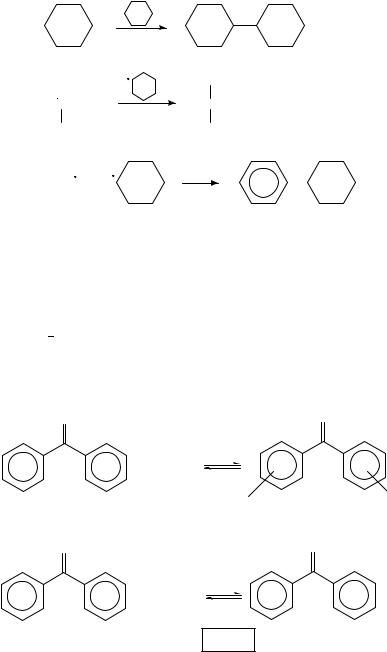
17. Syntheses and uses of isotopically labelled compounds |
1077 |
|
• |
• |
|
|
(309) |
|
|
(524) |
|
|
OH |
|
|
|
|
PhCCH2 Ph |
PhCCH2 Ph |
(310) |
|
|
|
OH |
C6 H11 |
|
|
(525) |
|
PhCH2 + |
CH |
(310a) |
|
|
|
|
(526) |
|
2. EPR, MS and GC study of the equilibrium isotope effects in the electron transfer from ketyls to isotopically different benzophenones
The [sym-dodeca-13C] benzophenone (equation 313) has been synthesized via FriedelCrafts phenylation of carbon tetrachloride and subsequent dehalogenation of the product using [per-13C] benzene. C12D1013CO and C12H1013CO were applied637 in the EPR and MS study of the electron transfer from ketyls to isotopically substituted ketones (equation 311 313). The equilibrium constants Keq at 75 °C, for electron transfer from the anion radicals of polyatomic hydrocarbons (Až ) to their isotopic analogues (B), Až C B ! A C Bž , in liquid ammonia, when A D benzophenone, have been found to be 0.52, 0.50 and 0.83 for the equilibrium involving B D perdeuteriated benzophenone, [carbonyl-13C] benzophenone and [sym-dodeca-13C] benzophenone.
|
O |
|
|
O |
|
− |
• |
+ (C6 D5)2 CO |
− |
• |
|
|
|
|
D5 |
D5 |
|
Keq = 0.52 ± 0.04 at −75 °C (Reference 637) |
|
+ (C6 H5)2 CO |
|||
|
|
|
|
(311) |
|
|
O |
|
|
O |
|
|
|
|
|
|
|
- |
• |
- |
• |
||
+ (C6 H5)2 CO |
|||||
|
|
|
|
+ (C6 H5)2 CO |
|
|
|
|
C = 13 C |
||
|
|
|
|
(312) |
|
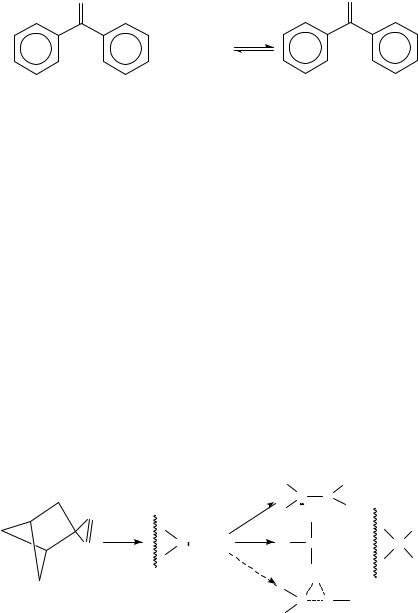
1078 |
Mieczysław Ziełinski´ and Marianna Kanska´ |
|
|
|
||||||
|
O |
|
|
|
|
|
O |
|
|
|
|
|
|
|
|
|
|
|
|
|
|
- |
• |
+ |
- |
• |
||||||
(C6 H5)2 CO |
|
|
|
|
||||||
|
|
|
|
|
|
|||||
+ (C6 H5)2 CO(313)
The observed greater attenuation of the electron affinity by substitution of the carbonyl carbon with 13C than in the case of substitution of all the ring carbons combined has been attributed to the fact that the carbonyl moiety has the highest charge and spin density in the benzophenone anion radical. The extremely large values of equilibrium 13C isotope effects by far exceed the magnitude of 13C IEs expected by the statistical mechanics638 theory of equilibrium isotope effects. The equilibrium 13C IEs in equation 312a have therefore been reinvestigated639 using the more accurate GC instead of quantitative ESR and mass spectroscopy.
Ph2CO |
C |
Ph2 |
13CO MC |
Ph2CO MC |
C |
Ph213CO |
312a |
|
|
|
|
|
|
It appeared639 that the solution electron affinity of [12CO] benzophenone in liquid ammonia is only 2.1% higher than that of [13CO]benzophenone, and not 100% higher as maintained by Stevenson and coworkers637. The source of systematic errors in the ESR and MS methodology of 13C/12C determinations which resulted in the unrealistic results in Stevenson and coworkers study has been pointed out by Holm639. Some details concerning the improved analytical procedures are described in other work640.
3. Deuterium study of the reactions of carbenes with OH bond
In the course of studies of the insertion of carbenes, generated in the photolysis of spirocyclic diazarines, 528, into OH bonds (equation 314) it has been observed641 that formation of ethers from carbene 527 and ROH(D) is associated with partial rearrangement (equation 315).
|
|
|
C− |
+ |
R |
|
|
|
|
O |
H |
||
N |
|
|
|
|
||
|
|
|
|
|
H |
|
|
|
|
C+ |
−OR |
||
N |
C |
+ ROH |
C |
|||
|
|
|
|
|
|
|
|
|
|
|
|
|
OR |
|
|
|
H |
|
|
|
(528) |
|
|
C |
O |
|
R |
(314)
4. Photochemistry of ortho-benzoylbenzaldehyde in D2O
530 and 531 are produced in the laser flash photolysis of o-benzoylbenzaldehyde, 532, in benzene or acetonitrile642. At high water concentration (>10 M) a new species 533
